Rajagopalaswamy Temple Mannargudi: 10th CE Famous Dakshina Dvaraka
The Rajagopalaswamy Temple is a Vaishnava shrine dedicated to Lord Krishna, located in the town of Mannargudi, Tamil Nadu, India. It is one of the largest and most important Vaishnava temples in Tamil Nadu, and is known for its rich history, architecture, and festivals.
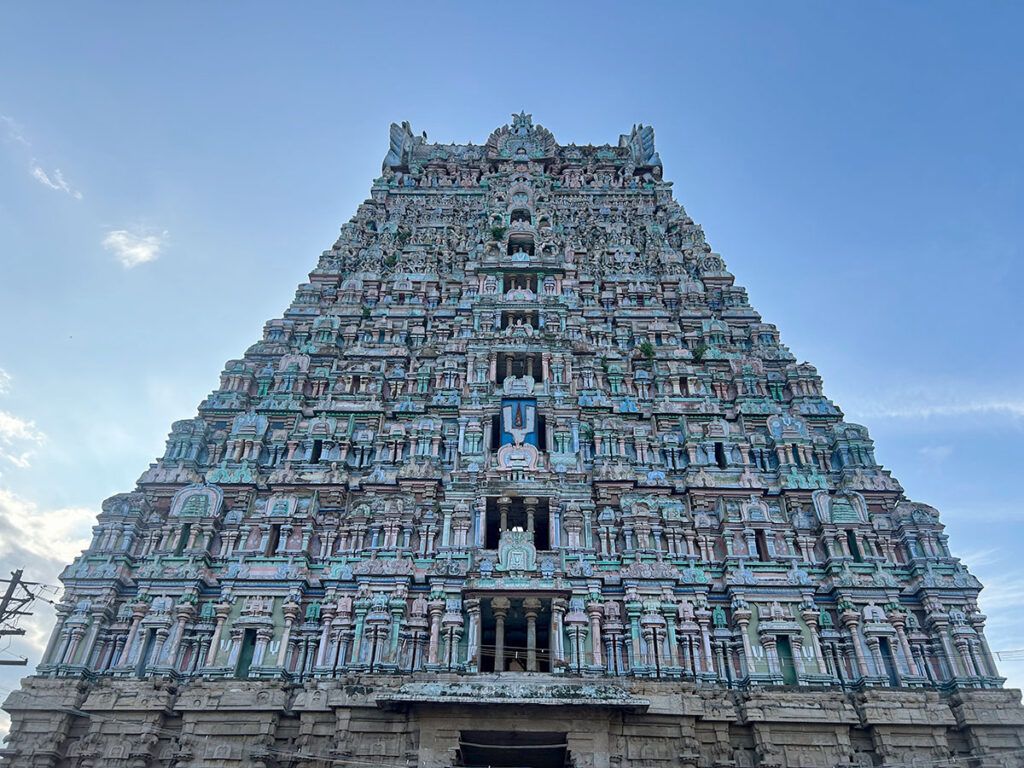
Contents
- 1 History of Rajagopalaswamy Temple Mannargudi:
- 2 Legend of Rajagopalaswamy Temple Mannargudi:
- 3 Significance of Rajagopalaswamy Temple Mannargudi:
- 4 Myths and Beliefs of Rajagopalaswamy Temple Mannargudi:
- 5 Architecture of Rajagopalaswamy Temple Mannargudi:
- 6 Rajagopalaswamy Temple Timing:
- 7 Festivals at the Rajagopalaswamy Temple, Mannargudi
- 8 Places to visit near Rajagopalaswamy Temple:
- 9 FAQ:
- 9.0.1 Where is the Rajagopalaswamy Temple located?
- 9.0.2 What is the main deity of the temple?
- 9.0.3 When was the temple built?
- 9.0.4 What are the dimensions of the temple?
- 9.0.5 What are the festivals celebrated at the temple?
- 9.0.6 What are the timings of the temple?
- 9.0.7 What is the dress code for visiting the temple?
- 9.0.8 How can I get to the temple?
- 9.0.9 What are the facilities available at the temple?
- 9.0.10 What are some of the other things to see and do in Mannargudi?
- 9.0.11 Why is Mannargudi famous?
- 9.0.12 How tall is the Mannargudi big temple in feet?
- 10 How to reach Rajagopalaswamy Temple Mannargudi:
- 11 Google Maps:
History of Rajagopalaswamy Temple Mannargudi:
Early Beginnings (10th – 12th Centuries):
- The temple’s origins trace back to the 10th century, with the initial construction attributed to Chola king Kulothunga Chola I (1070-1125 CE).
- Inscriptions found at the site confirm the Chola era construction, using bricks and mortar.
- The town of Mannargudi itself developed around the temple, initially known as “Sri Rajathi Raja Chathurvedhi Mangalam.”
- Subsequent Chola kings, Rajaraja Chola III and Rajendra Chola III, also contributed to the temple’s expansion.
Growth and Transformation (16th – 18th Centuries):
- The Thanjavur Nayak dynasty played a pivotal role in shaping the temple’s present form.
- They made the temple their primary and dynastic shrine, undertaking significant additions and renovations.
- Achyuta Deva Raya, a prominent Nayak king, actively participated in temple expansions.
- This period witnessed the construction of the imposing 154 feet tall Rajagopuram, the temple’s gateway tower, making it the fourth tallest among Vishnu temples in Tamil Nadu.
- The Nayak influence is evident in the temple’s architectural style, blending Dravidian and Vijayanagara elements.
Later Contributions and Legend:
- Inscriptions from the Hoysala kings and Vijayanagara grants further highlight the diverse influences on the temple’s development.
- Numerous records from the later Nayak and Maratha periods offer valuable insights into the temple’s history and administration.
- One intriguing legend associated with the temple is that of Thirumangai Azhvaar, a revered Vaishnavite saint.
- He is said to have visited the temple, lifted the fallen flag post (dwajastambam), and left without offering any hymns to the deity.
- This unusual act signifies the immense reverence and faith he held for the Lord, transcending the need for conventional rituals.
Present Day:
- Today, the Rajagopalaswamy Temple stands as a magnificent testament to its rich history and cultural significance.
- It is revered as one of the most important Vaishnavite shrines in India, often referred to as “Dakshina Dwarka” alongside the famous Guruvayoor Temple.
- The temple attracts thousands of devotees daily, seeking blessings and participating in vibrant festivals throughout the year.
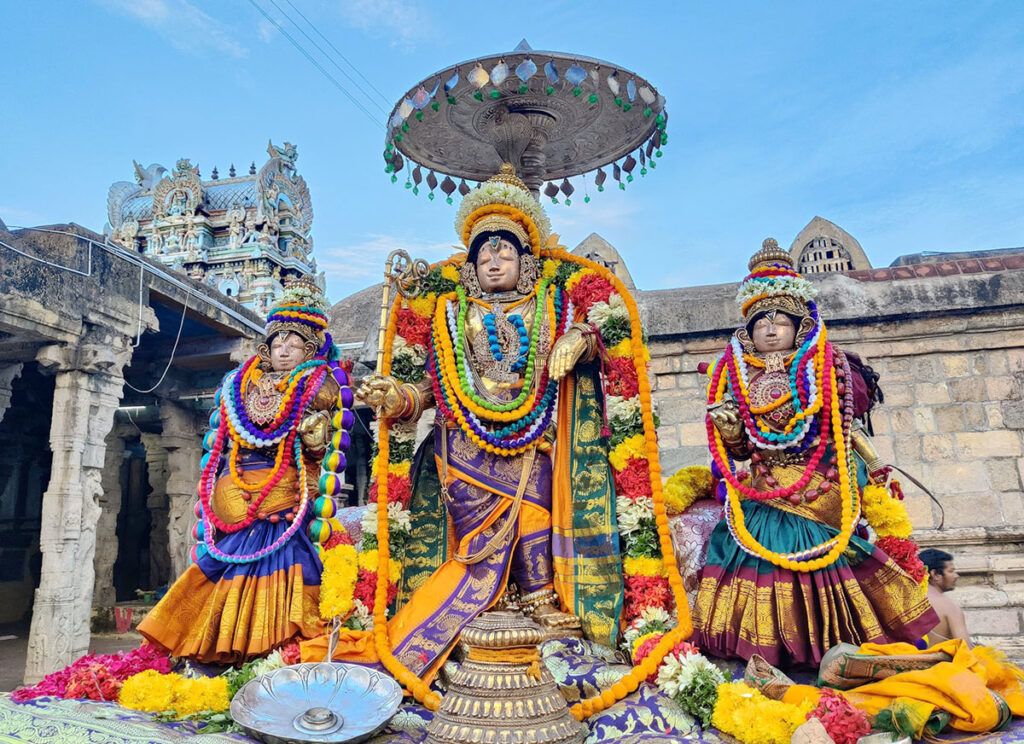
Legend of Rajagopalaswamy Temple Mannargudi:
Origin Story:
The temple’s origin dates back to the Chola dynasty, with inscriptions mentioning King Kulothunga Chola I (1070-1125 A.D.) as the initial builder. Though initially constructed with bricks and mortar, later Chola kings like Rajaraja Chola III and Rajendra Chola III expanded the temple, adding to its architectural marvels. The Vijayanagara kings, Thanjavur Nayaks, and Marathas further embellished the temple complex, making it the majestic structure it is today.
The Legend of Thirumangai Azhvaar:
One of the most captivating legends associated with the temple is the story of Thirumangai Azhvaar, a renowned Vaishnava saint. Legend has it that he visited the temple but was shocked to find the flag post (dwajastambam) lying on the ground. In a display of divine anger, he lifted the giant flag post with his bare hands and set it upright. However, he did not sing any hymns in praise of the Lord and simply left the temple. This act of “silent praise” is still commemorated at the temple, with the flag post remaining slightly tilted to this day.
The Unique Earring:
Another fascinating legend revolves around the unique adornment of the idol. Unlike most depictions where Lord Krishna wears identical earrings, here, he sports two distinct ones. One ear adorns his trademark kundalam, while the other bears a Gopiyar’s earring. This peculiarity is attributed to a playful incident where Krishna, in his eagerness to win a race with the Gopis, ended up wearing their earring in one ear and his own in the other. This unique iconography further adds to the temple’s charm and draws devotees from far and wide.
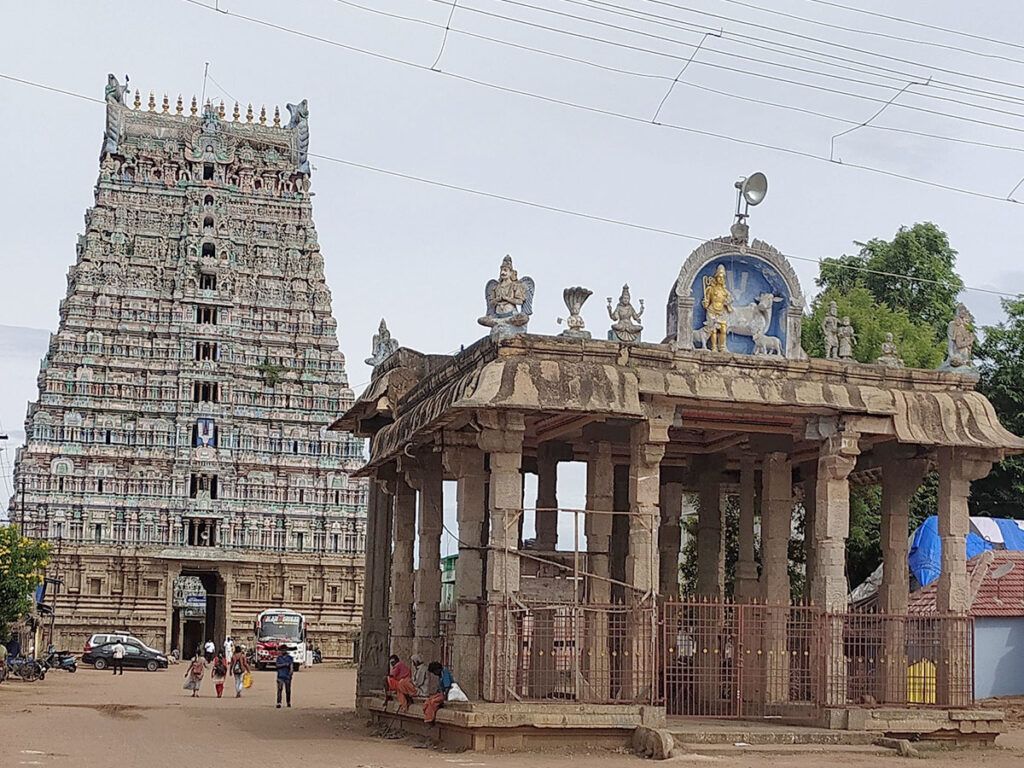
Significance of Rajagopalaswamy Temple Mannargudi:
- Historical Significance: The temple boasts a rich history dating back to the 10th century. It was initially built by Chola king Kulothunga Chola I and subsequently expanded by later Chola rulers like Rajaraja Chola III and Rajendra Chola III. In the 16th century, the Nayak kings further contributed to its grandeur.
- Architectural Marvel: The temple sprawls over a vast 23 acres and showcases magnificent Dravidian architecture. Its towering gopurams (gateway towers), intricately carved sculptures, and spacious halls leave visitors in awe.
- Religious Importance: The Rajagopalaswamy Temple is considered one of the most important Vaishnava shrines in India. It is particularly revered by followers of Sri Vaishnavism, a prominent Hindu sect.
- Festivals and Celebrations: The temple hosts several vibrant festivals throughout the year, drawing devotees from far and wide. The most popular festival is the Brahmotsavam, celebrated in the Tamil month of Chittirai (April-May), which lasts for ten days and features grand processions, cultural performances, and religious discourses.
- Spiritual Power: The temple is renowned for its serene atmosphere and powerful vibrations, attracting devotees seeking spiritual solace and blessings.
- Cultural Hub: The temple complex also houses a significant collection of ancient scriptures, manuscripts, and artifacts, contributing to the cultural heritage of the region.
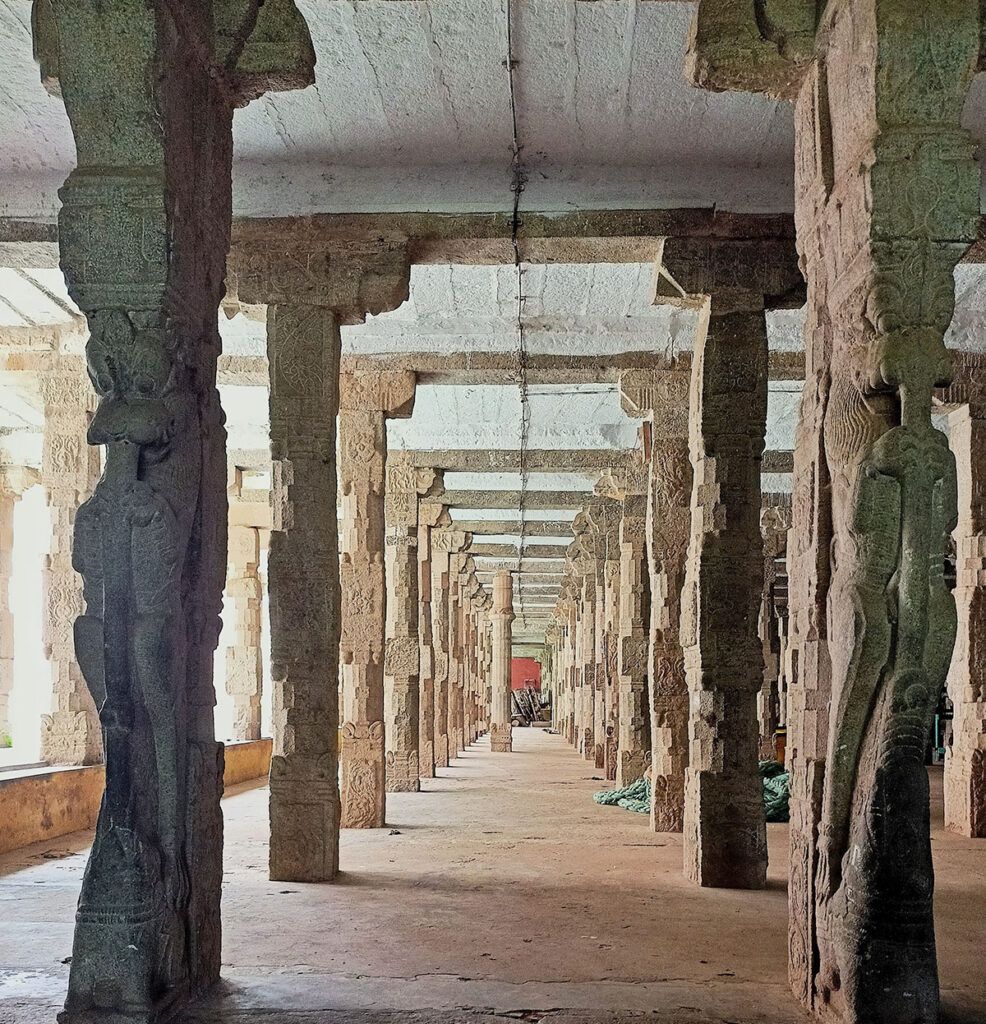
Myths and Beliefs of Rajagopalaswamy Temple Mannargudi:
1. Thirumangai Alvar and the Tall Flag Post:
One of the most popular beliefs is the story of Thirumangai Alvar, a revered saint poet of the 7th century. He is credited with building the temple’s towering flag post, measuring 232 feet. Legend has it that he used cotton bales to reach the top, showcasing his unwavering devotion to Lord Krishna.
2. Krishna’s Leela of Stealing Gopis’ Clothes:
The temple celebrates a fascinating festival recreating the famous leela (divine play) of Krishna stealing the clothes of gopis (cowherd maidens) while they bathed in the Yamuna River. This playful act is believed to symbolize Krishna’s mischievous nature and his desire to teach the gopis a lesson in detachment. The festival involves a reenactment of the scene, followed by a procession of Krishna and the gopis.
3. The Divine Flute and its Power:
The temple houses a unique flute said to be played by Lord Krishna himself. Believers hold the belief that the sound of this flute possesses miraculous healing powers and can bring peace and tranquility to troubled minds.
4. The Legend of the Nine-hooded Serpent:
The temple complex is believed to have been built on a spot where Lord Krishna vanquished a nine-hooded serpent named Adishesha. This victory signifies the triumph of good over evil and is commemorated through murals and sculptures within the temple.
5. Wish-fulfilling Tree:
Within the temple grounds stands a revered banyan tree known as the “Kalpavriksha” or the “wish-fulfilling tree.” Devotees believe that praying and tying sacred threads around this tree can help their wishes come true.
6. The Seven Steps to Enlightenment:
The temple’s architecture itself holds significant meaning. The seven entrances are believed to represent the seven steps towards spiritual enlightenment, and each step involves overcoming certain obstacles and attaining higher levels of consciousness.
7. Divine Intervention:
Many devotees believe that Lord Krishna intervenes in their lives, providing guidance and support through divine blessings. This belief strengthens their faith and encourages them to lead a righteous life.
8. The Power of Chanting:
Chanting the holy names of Lord Krishna, particularly the “Hare Krishna Mahamantra,” is considered highly meritorious at the temple. Devotees believe that chanting can purify the mind, remove negativity, and bring them closer to the divine.
9. A Place of Healing:
Besides spiritual benefits, the temple is also associated with healing powers. Devotees believe that offering prayers and performing rituals at the temple can cure illnesses and alleviate suffering.
10. An Abode of Peace and Tranquility:
The temple’s serene atmosphere, with its lush gardens and soothing chants, provides a sanctuary for devotees seeking solace and peace. The belief in the temple’s sanctity and the presence of Lord Krishna creates a powerful aura that promotes inner peace and spiritual well-being.
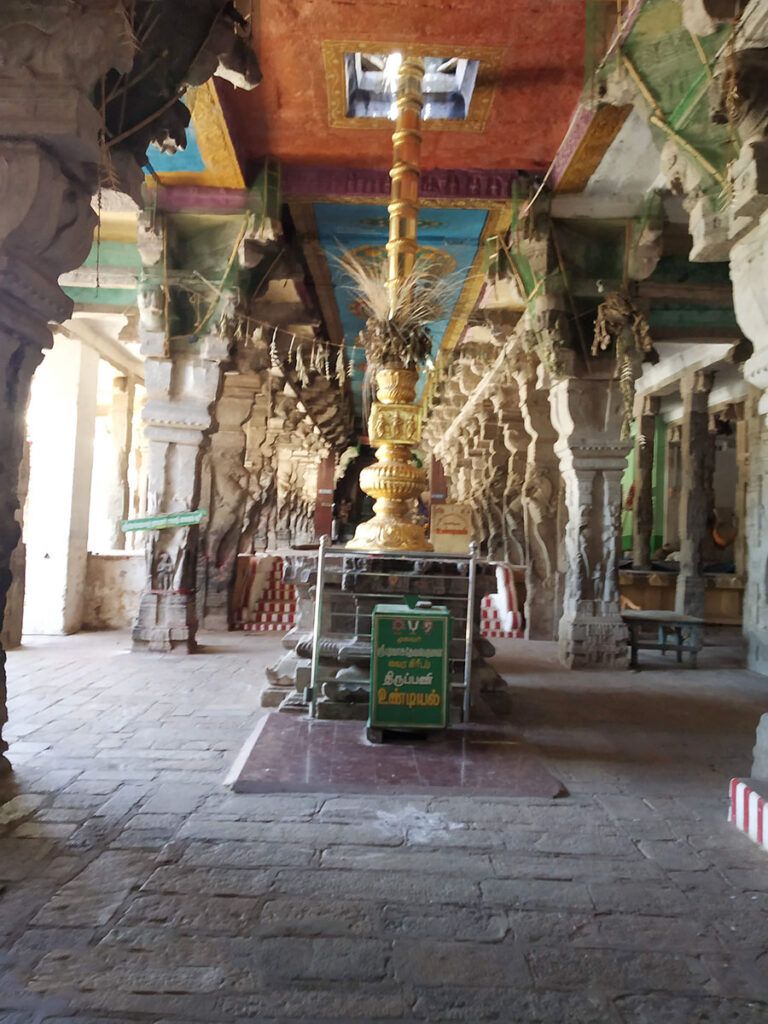
Architecture of Rajagopalaswamy Temple Mannargudi:
Rajagopuram: The temple’s most prominent feature is its towering rajagopuram (gateway tower), which stands at a height of 192 feet (59 meters). This massive structure is adorned with intricate carvings of deities, mythical creatures, and floral motifs.
Prakarams: The temple complex is divided into seven concentric prakarams (courtyards), each enclosed by high walls and adorned with sculptures and reliefs.
Shrines: The complex houses a total of 24 shrines, dedicated to various deities, including Lord Vishnu, his consorts, and other deities of the Hindu pantheon.
Mandapams: The temple features seven mandapams (halls), each with its own unique architectural style. These halls are used for various rituals and ceremonies.
Temple Tanks: Nine sacred theerthams (temple tanks) are located within the temple complex. These tanks are believed to have healing properties and are used for ritual bathing.
Utsava Murthy: The temple’s most revered image is the Utsava Murthy, a bronze figure of Lord Vishnu that is believed to be from the Chola period. This exquisite statue is adorned with precious stones and jewels and is taken out in procession during festivals.
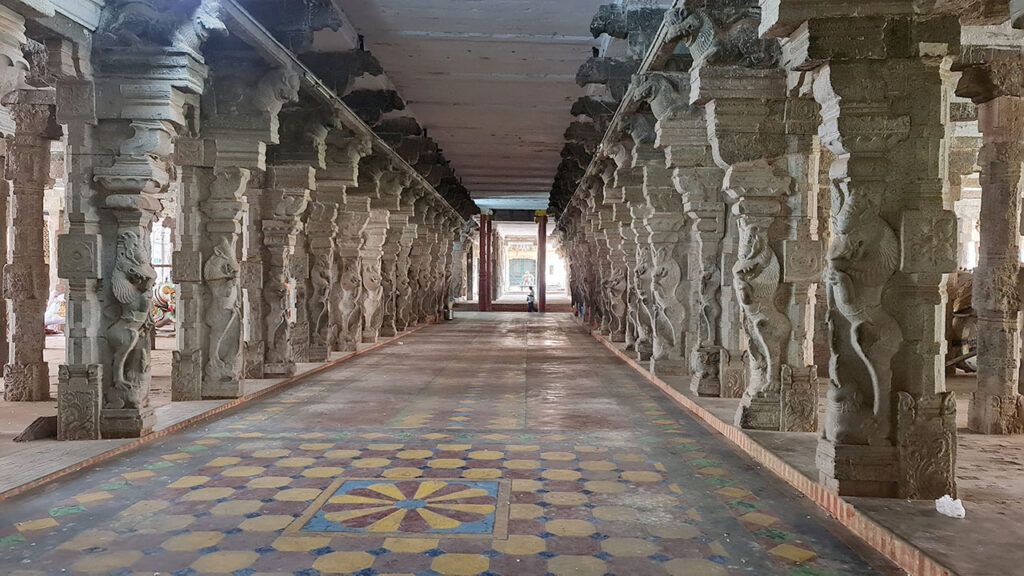
Rajagopalaswamy Temple Timing:
Morning:
- Kalasandhi: 8:30 AM
- Uchikalam: 10:00 AM
Evening:
- Sayarakshai: 6:00 PM
- Ardha Jamam: 8:00 PM
Each ritual involves three steps:
- Alangaram: Decoration of the deity
- Neivedhyam: Food offering to the deity
- Deepa Aradanai: Waving of lamps before the deity
Festivals at the Rajagopalaswamy Temple, Mannargudi
The Rajagopalaswamy Temple, located in Mannargudi, is a vibrant center of Vaishnavite faith. It is renowned for its stunning architecture and its vibrant festivals that attract devotees from far and wide. Here are some of the most significant festivals celebrated at the temple:
1. Panguni Brahmotsavam (March-April):
This is the most important festival of the temple, celebrated over 18 days during the Tamil month of Panguni (March-April). The festival culminates in a grand chariot procession, where devotees pull a massive chariot carrying the deity, Rajagopalaswamy, through the streets of Mannargudi.
2. Aadi Pooram (July-August):
This festival is celebrated during the Tamil month of Aadi (July-August) and commemorates the birth of Lord Krishna. It features a grand procession with the deity adorned in colorful ornaments and showered with flowers.
3. Vaikunta Ekadashi (December-January):
This festival falls on the 11th day of the waxing moon in the Tamil month of Margazhi (December-January). It celebrates the descent of Lord Vishnu to Earth and is marked by special pujas, prayers, and discourses.
4. Navarathri (September-October):
This nine-day festival is celebrated in the Tamil month of Purattasi (September-October) and honors the nine forms of Goddess Durga. Special pujas and cultural programs are held during this time.
5. Oonjal festival (February-March):
This unique festival is held during the Tamil month of Masi (February-March) and features the deity being adorned with garlands and placed on a swing. Devotees sing devotional songs and offer prayers to the deity.

Places to visit near Rajagopalaswamy Temple:
Garuda Sthambam: This is a 50-meter tall pillar that was built in the 16th century. It is located about 1 km from the temple.The pillar is made of granite and is decorated with carvings of Hindu gods and goddesses. It is a popular tourist destination and is often used as a backdrop for wedding photos.
Sengamalam Elephant Shelter: This shelter is home to over 50 elephants. It is located about 2 km from the temple.The shelter was founded in 1992 and is home to elephants that have been rescued from circuses, zoos, and other forms of captivity. The shelter provides the elephants with a safe and healthy environment where they can live out their natural lives.
Temple Garden: This garden is located next to the temple and is a great place to relax and enjoy the scenery. The garden is home to a variety of plants and flowers, as well as a number of statues and sculptures. It is a popular spot for locals and tourists alike.
Rajagopalaswamy Temple: This temple is dedicated to the Hindu god Vishnu. It is one of the most important temples in Tamil Nadu.The temple is one of the 108 Divya Desams, which are the most sacred temples dedicated to Vishnu. The temple is known for its beautiful architecture and its large collection of sculptures.
FAQ:
Where is the Rajagopalaswamy Temple located?
The Rajagopalaswamy Temple is located in the town of Mannargudi, which is in the Thiruvarur district of Tamil Nadu, India.
What is the main deity of the temple?
The main deity of the temple is Rajagopalaswamy, a form of Krishna. The temple is dedicated to Krishna in his role as the protector of the cows and the people of Mannargudi.
When was the temple built?
The temple was originally constructed by Kulothunga Chola I in the 10th century. Later, it was expanded by the Chola kings Rajaraja Chola III and Rajendra Chola III, and then again by the Thanjavur Nayaks in the 16th century.
What are the dimensions of the temple?
The temple is spread over an area of 23 acres (93,000 m2). It has nine gopurams (gateway towers) and seven prakarams (concentric enclosures).
What are the festivals celebrated at the temple?
The temple celebrates a number of festivals throughout the year, including the Brahmotsavam festival in April-May, the Avani Utsavam festival in August-September, and the Vaikunta Ekadasi festival in November-December.
What are the timings of the temple?
The temple is open from 5:00 AM to 12:00 PM and from 4:00 PM to 8:00 PM.
What is the dress code for visiting the temple?
Devotees are expected to dress modestly when visiting the temple. Men should wear shirts and pants, and women should wear sarees or salwar kameez.
How can I get to the temple?
The temple is located about 110 kilometers from the city of Madurai and about 135 kilometers from the city of Trichy. The nearest airport is the Tiruchirappalli International Airport, which is located about 125 kilometers from the temple.
What are the facilities available at the temple?
The temple has a number of facilities for devotees, including rest houses, a dining hall, and a medical center.
What are some of the other things to see and do in Mannargudi?
Mannargudi is a town with a rich history and culture. There are a number of other temples and historical sites that can be visited, including the Haridra Nadhi (a holy river), the Neelameghaperumal Temple (a temple dedicated to Vishnu), and the Mannargudi Fort.
Why is Mannargudi famous?
1. The Rajagopalaswamy Temple: The most prominent reason for Mannargudi’s fame is the Rajagopalaswamy Temple. This massive temple complex dedicated to Lord Krishna is a prominent Vaishnavite shrine and a major pilgrimage destination. It is known for its intricate architecture, expansive halls, and vibrant festivals like the Brahmotsavam and Avani Utsavam.
2. Agriculture and Weaving: Mannargudi is a major center for agriculture and weaving. The fertile land surrounding the town produces a variety of crops, including rice, sugarcane, and cotton. The town is also known for its skilled weavers, who produce beautiful sarees, dhotis, and other textiles.
3. Metal Working: Mannargudi has a long history of metal working, dating back to the Chola dynasty. The town is known for its skilled craftsmen who create a variety of metal objects, including jewelry, utensils, and sculptures.
4. Mineral Deposits: The region around Mannargudi is rich in mineral deposits, including iron ore, limestone, and lignite. These resources have played a significant role in the development of the town’s economy.
5. Cultural Heritage: Mannargudi has a rich cultural heritage, and its residents celebrate a variety of festivals and traditions throughout the year. The town is also home to a number of historical sites, including temples, forts, and palaces.
How tall is the Mannargudi big temple in feet?
The main gopuram (gateway tower) of the Mannargudi Rajagopalaswamy Temple, also known as the “big temple”, stands at a height of 192 feet (59 meters). It is the second largest gopuram in Tamil Nadu after the Srirangam Ranganathaswamy Temple gopuram.
How to reach Rajagopalaswamy Temple Mannargudi:
By Air: The nearest airport is Tiruchirapalli International Airport (IATA: TRZ), located approximately 90 kilometers away from Mannargudi. From the airport, you can hire a taxi or use other local transportation to reach Mannargudi.
By Train: Mannargudi has its own railway station, Mannargudi Railway Station (MQ), which is well-connected to various cities in Tamil Nadu and other parts of India. You can check the train schedules and book tickets to Mannargudi based on your location.
By Road: Mannargudi is well-connected by road, and you can reach the town by bus or car. If you are traveling by bus, you can check the Tamil Nadu State Transport Corporation (TNSTC) or private bus services that connect Mannargudi with nearby towns and cities.
